Spain is dangerous this winter!
Monday, December 1, 2025
 There are a number of health warnings in Spain for the coming winter: influenza, Avian flu, African swine fever, Tetanus, and of course, Coronavirus is still a threat. There are a number of health warnings in Spain for the coming winter: influenza, Avian flu, African swine fever, Tetanus, and of course, Coronavirus is still a threat.
There are 3,000 new cases of AIDS diagnosed each year in Spain.
Plus freezing temperatures.
[CPWR]
This is all dangerous, particularly for older people. Which is what I am, according to my birth certificate, even though I feel much younger.
Action Plan
 The fifth Covid-19 injection is now available for over 70-year-olds. The fifth Covid-19 injection is now available for over 70-year-olds.
They don't contact you any longer, you have to ring your local health centre or ambulatorio to make an appointment.
I shall be doing that tomorrow.
[EL PAIS]
You also get a 'flu jab and a tetanus top-up at the same time. So three pricks in two arms!
Your upper arms are sore for two or three days and you might have a slight attack of Covid, but, in my opinion, it's better to be protected.
I don't have AIDS nor African swine fever. Touch wood!
Elsewhere
 Some members of the German side of my family are refuseniks when it comes to Coronavirus injections and only get top-up Covid jabs if they really have to, for example to get into a restaurant or to book into a hotel. Some members of the German side of my family are refuseniks when it comes to Coronavirus injections and only get top-up Covid jabs if they really have to, for example to get into a restaurant or to book into a hotel.
I think they're nuts, but that's their choice, I guess.
So long as they don't infect me or the missus!
[BBC]
Here in Spain
The authorities are predicting more deaths this winter, because of the predicted cold. Two regions have re-introduced the compulsory wearing of masks, and others, like Andalucia, are recommending their use in medical settings, including pharmacies.
Most houses here are not well built. Cavity walls? "Forget it!" Insulation? "Ha-ha-ha!"
 A professional friend of mine, a neighbour, has no heating whatsoever in her finca. She just wraps up warm! A professional friend of mine, a neighbour, has no heating whatsoever in her finca. She just wraps up warm!
She does at least have a traditional brasera under her dining table!
I've offered to act as a human hot water bottle for her, but up to now she's not accepted!
What a shame! She's pretty, very "sexy", single, a good 10 years younger than me and Spanish to boot!
[Wikipedia]
Last word
These winter threats need to be taken seriously. I mean it!
© Pablo de Ronda
Links:
5 years of Covid-19 - The last post
Covid-19 is a thing of the past – or is it?
Is the Covid Crisis Over?
Pictures:
BBC, CPWR, EL PAIS, Wikipedia
Acknowledgements:
Diario Sur, Pablo de Ronda, Sur in English, TIME, Wikipedia
Tags:
AIDS, African swine fever, Avian flu, BBC, CPWR, Coronavirus injection, Diario Sur, EL PAIS, freezing temperatures, health centre, health warning, human hot water bottle, influenza, masks, medical settings, Pablo de Ronda, pharmacies, Sur in English, Tetanus, TIME, top-up Covid jab, Wikipedia
 0
Like
Published at 9:10 AM Comments (0)
0
Like
Published at 9:10 AM Comments (0)
Ronda Valley Hotel to close? F**k!
Friday, November 28, 2025
The worst kept secret around these parts is that the Ronda Valley Hotel (formerly Hotel Don Benito) is to close its doors on 15th January 2026. WTF! Why?
 This hotel is my nearest local, so from a selfish point of view, I think it's a disaster. This hotel is my nearest local, so from a selfish point of view, I think it's a disaster.
Talking with other "guiris" who live nearby, it's a catastrophe for them also.
Ronda Valley Hotel [Photo: A1 Inmobiliaria]
The local folk, almost all andaluces, mostly involved with agriculture - olives, grapes, hortalizas of all kinds - or livestock farmers - sheep, goats, pigs and cattle - this is where they come to chill out after work and quench their raging thirsts.
Backstory
I've lived around here for 17 years and I've experienced a number of different "owners" and at least three name changes to the hotel in question.
For many years it was Hotel Don Benito, then La Posada de Ronda and latterly Ronda Valley Hotel.
 The owner was Pedro, but he died a couple of years ago. His only heir is a daughter who has no interest in running a hotel, just like her dad. Pedro always leased the hotel to others to run. The owner was Pedro, but he died a couple of years ago. His only heir is a daughter who has no interest in running a hotel, just like her dad. Pedro always leased the hotel to others to run.
I can remember Manolo from Ronda; a German couple from, well, Germany; Luis from Arriate; and Sergio and Manuel from Lisbon, Portugal.
Mural in the refurbished bar [Andalucia.org]
The most successful have been the Portuguese, even though they never come, leaving the hotel in the hands of a manager.
So, what's going on?
You hear lots of stories but are they true?
Final Musings
So, we have another two months before the place closes.
 I really don't get it. This hotel has so much potential. I really don't get it. This hotel has so much potential.
Easy to get to, also for passing motorists; massive free car park; bar; restaurant; function room; large outside terrace; 20 rooms; extensive grounds with tennis court, padel court and swimming pool; barbecue area.
The large terrace [Atrapalo]
If I were three decades younger; had a background in hospitality; and had the money, I would be first in the queue to buy it.
Talking it over with two local estate agents, one estimated that the purchase price would be around 1.2 million euros; the other 1.8 million. Quite a difference! The latter estimate was because of the potential of the hotel and grounds.
 My big idea is that they need to hold live music events on the terrace or in the function room. A guaranteed money-spinner if done properly. There is already a strong tradition of live music in the Serrania de Ronda, eg at the Irish Bar in Ronda; Allioli Bar y Mas in Jimera de Libar; and Bar Restaurante EntreAscuas in Montejaque. My big idea is that they need to hold live music events on the terrace or in the function room. A guaranteed money-spinner if done properly. There is already a strong tradition of live music in the Serrania de Ronda, eg at the Irish Bar in Ronda; Allioli Bar y Mas in Jimera de Libar; and Bar Restaurante EntreAscuas in Montejaque.
[Allioli bar y mas]
Another good idea would be tapas at the bar.
Changing the horario of the restaurant would be a smart move: 7.00 - 10.30 would be welcomed by the very many hotel guests from Northern Europe, USA and Canada.
And also by some of the locals.
[Sign by Mar y Ram]
The bedrooms need a makeover. They are a bit dated, basic and shabby. Once the renovation is completed the hotel could "up" its prices. 30 € a night for a double room off-season is way too cheap.
Let's hope somebody comes along and buys the hotel and fulfils its potential.
Otherwise, we locals will have to either give up drinking or travel further afield.
Arrgh!
STOP PRESS:
This evening, Tuesday December 2nd, the hotel was shut and displaying a "closed for holidays" sign.
The Ronda Valley is always open - it's a proper hotel, which always has guests who need to eat and have a drink.
The bar is a public one, open to the many locals who enjoy a few drinks before going home for dinner and also to passing trade.
[Adobe Stock]
So, why has it shut? It seems a bit fishy to me.
© Pablo de Ronda
Links:
Another - new – Ronda Valley
The other "Ronda valley"
Pictures:
A1 Inmobiliaria, Adobe Stock, Allioli Bar y Mas, Andalucia.org, Atrapalo, Mar y Ram
Thanks:
A1 Inmobiliaria, Eye on Spain, LoveViviendas, Pablo de Ronda, Paul Whitelock, Sierra Estates
Tags:
A1 Inmobiliaria, Adobe Stock, Allioli Bar y Mas, Andalucia.org, Atrapalo, Bar Restaurante EntreAscuas, Eye on Spain, Hotel Don Benito, Irish Bar in Ronda, Jimera de Libar, La Posada de Ronda, LoveViviendas, Luis from Arriate, Manolo from Ronda, Mar y Ram, Montejaque, Pablo de Ronda, Paul Whitelock, Portugal, Ronda Valley Hotel, Sergio and Manuel from Lisbon, Serrania de Ronda, Sierra Estates
 0
Like
Published at 6:55 PM Comments (0)
0
Like
Published at 6:55 PM Comments (0)
All about Spanish surnames
Friday, November 28, 2025
 Spanish surnames (apellidos - they have two, one from their father and another from their mother) can be classified into four main types. Spanish surnames (apellidos - they have two, one from their father and another from their mother) can be classified into four main types.
Knowing about the past allows us to learn a bit more about ourselves, where our culture comes from, what our history is, what our families were like.
[Image courtesy of Wikipedia]
All this has been concentrated into our surnames, a thread which tells us about our past.
 In an article for AS, the Spanish sports daily, journalist Marta Tejedor talks readers through the four categories. In an article for AS, the Spanish sports daily, journalist Marta Tejedor talks readers through the four categories.
***
[AS]
I've edited Marta's article and translated it into English.
The original edited article in Spanish is here:
Spanish surnames - apellidos
***
Spanish surnames are divided into four types: find out which type your surname belongs to
By Marta Tejedor
2 minutes read
 According to the newspaper OK Diario, experts have created four main types of Spanish surnames into which they can be classified. According to the newspaper OK Diario, experts have created four main types of Spanish surnames into which they can be classified.
Depending on the category they belong to, the surname in question can provide certain information about its origin.
[ElPlural.com]
Among these categories are patronymic surnames, toponymic surnames, surnames derived from common names, and surnames derived from trades or professions.
Which type of surname does yours belong to?
Patronyms
 This type of surname indicates the name of the father or ancestor from whom it originates. This type of surname indicates the name of the father or ancestor from whom it originates.
They are very common in Spain and in some Spanish-speaking countries.
Among them, some stand out, such as Pérez, which means “son of Pedro”; Sánchez, “son of Sancho”; or Fernández, “son of Fernando.”
[Facebook]
This type of surname usually ends in -ez, -az, -iz, -oz, -uz.
Toponyms
 This category includes all surnames whose meaning indicates the place of origin or residence of the bearer or their ancestors, according to YouTube. This category includes all surnames whose meaning indicates the place of origin or residence of the bearer or their ancestors, according to YouTube.
Interestingly, some examples of these surnames are Torres, Castellano, or Castillo, all of them originating from Castilla. Other examples are Navarro and Navarrete, both originating from Navarra.
[Slideshare]
Derived from common names
 Very similar to patronyms, this category of surnames is based on some physical, moral, or religious trait of the bearer or their ancestors. Very similar to patronyms, this category of surnames is based on some physical, moral, or religious trait of the bearer or their ancestors.
The surname Rubio is a clear example of how a physical trait of an ancestor has been passed down to their descendants. Other examples, like Bravo, originated from a brave act or from people considered courageous. Cruz, for example, can mean 'executed' or 'devoted to the cross.'
[Euribor hoy]
Derived from trades or professions
 In this category are all surnames whose meaning relates to the occupational or social activity of the bearer or their ancestors. In this category are all surnames whose meaning relates to the occupational or social activity of the bearer or their ancestors.
Some examples are Tejedor, Pastor, Herrera, or Molina, the latter coming from the work of a miller.
[Letra 15]
But there are not just these four types: there are also surnames that come from nicknames based on the bearer’s nickname, such as in the cases of Largo or Gordo.
 
Largo [Cartoon courtesy of Dreamstime] Gordo [Cartoon courtesy of Freepik]
***
Note: A similar article was published in Spanish here:
Spanish surnames - apellidos
© Paul Whitelock
Images:
AS, Dreamstime, ElPlural.com, Euribo hoy, Facebook, Freepik, Letra 15, Slideshare, Wikipedia, YouTube,
Acknowledgements:
Don Pablo, Paul Whitelock, Wikipedia
Tags:
apellido, Castellano, Castilla, Castillo, “cruzado”, Bravo, Cruz, Delgado, “devoto de la cruz”, English, Fernández, Gordo, Herrera, “hijo de Fernando”, “hijo de Pedro”, “hijo de Sancho”, Largo, Marta Tejedor, Molina, molinero, Navarra, Navarrete, Navarro, OK Diario, Pastor, Pérez, Rubio, Sánchez, Spanish, "Spanish Matters", surname, Tejedor, Torres,
 0
Like
Published at 9:19 AM Comments (0)
0
Like
Published at 9:19 AM Comments (0)
Alien customs - a British immigrant's view of Spain
Thursday, November 20, 2025
 This article is not specifically about me. This article is not specifically about me.
It's about foreigners, or "guiris", who move permanently to live in Spain, and often experience a kind of "culture shock".
[Video courtesy of YouTube]
Anna, a young Briton who moved recently to live in Madrid, explained her situation to the newspaper AS this week.
I too was a young Briton when I first came to Spain 50-odd years ago. I knew almost immediately that Spain would be my destiny, and, although it took me nearly 40 years to make the permanent move, I have now clocked up some 17 years as a resident.
 AS AS
Una británica que vive en Madrid revela las costumbres españolas que niega aceptar:
“Tengo que luchar bastante”
Historia de Marta Tejedor
Moving to a new country often requires getting to know new cultures, learning unfamiliar languages, and even accepting certain customs you didn't even know existed beforehand.
Spain is a country that welcomes millions of tourists every year, and some of them decide to stay longer to enjoy the country's climate and cuisine, amongst other things.
Anna, a TikToker who uploads content to her account on the social media platform, annainespana, talked about three things she can't stand about Spain.
Three Things She Can't Accept
The Heat
 High temperatures in summer are a daily occurrence in Spain, especially in Madrid, a city with more asphalt than green spaces. High temperatures in summer are a daily occurrence in Spain, especially in Madrid, a city with more asphalt than green spaces.
In June, July, and August, temperatures can reach up to 40 degrees Celsius (104 degrees Fahrenheit).
Anna confesses that the sun in Madrid is a lot hotter than in England, and that it's hard to get used to.
[Image courtesy of Dreamstime]
The Bureaucracy
 Coming to Spain as a tourist is relatively easy; the problem arises when an immigrant decides he wants to live in the country. Coming to Spain as a tourist is relatively easy; the problem arises when an immigrant decides he wants to live in the country.
At that point, a period of paperwork and obtaining permits begins that often seems never-ending.
[Image unattributed]
Anna explains that she had many problems obtaining her visa, not because she didn't meet the requirements, but because the process in Spain is slow and requires permits that often seem almost impossible to obtain.
Spanish Nightlife
 In England, people eat dinner and go to bed much earlier than Spaniards. The Spanish timetable is much more nocturnal than in Britain. Going out at nine or ten at night and returning home at three in the morning is something Anna is used to from the UK, yet that seems quite strange in Spain. In England, people eat dinner and go to bed much earlier than Spaniards. The Spanish timetable is much more nocturnal than in Britain. Going out at nine or ten at night and returning home at three in the morning is something Anna is used to from the UK, yet that seems quite strange in Spain.
In Spain, Anna has observed that people usually go out to clubs around midnight or one in the morning and return home around seven or eight at night the following day!
[Photo courtesy of Enjoy Travel]
“I prefer to sleep,” the TikToker confesses.
Paul aged 20
 I was shipped off to Spain in 1970 for my year abroad (I was studying for a degree in Spanish and German). I was shipped off to Spain in 1970 for my year abroad (I was studying for a degree in Spanish and German).
Our group was sent to San Sebastián to do a course for three months, followed by "doing our own thing" for a further three. In Spain of course.
I loved it and there began my dream to live in Spain one day.
View of San Sebastian [The Independent]
Paul aged 58
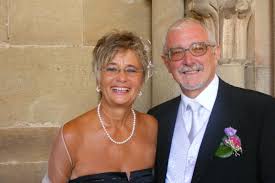 After marriage, two children, a 30-year career in education, redundancy and divorce, I finally made the move when, in 2008, I met a German lady who was already living in Spain who became my second wife in 2010. After marriage, two children, a 30-year career in education, redundancy and divorce, I finally made the move when, in 2008, I met a German lady who was already living in Spain who became my second wife in 2010.
I've been here ever since.
Our wedding in Maulbronn, Germany [HMR]
Paul aged 75
This year I reached the grand old age of 75. I'm in my 17th year as a resident and intend to stay put.
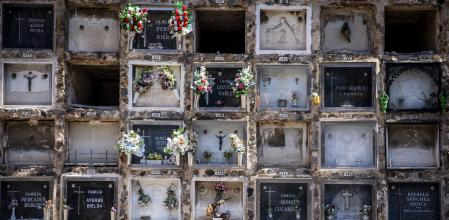 I shall die here. I've already reserved my nicho at the cemetery. I shall die here. I've already reserved my nicho at the cemetery.
I've also tidied up my affairs and written a new Will, which is valid in Spain, yet takes into account my current status as a British citizen.
[Photo of nichos by La Vanguardia]
The issues that still bother me are bureaucracy, litter, noise and the police (especially Guardia Civil Trafico).
But I shall continue to be patient, go through their processes and speak to officials cara a cara.
Conclusion
Back to the inspiration for this article, Anna, in Madrid. "Don't give up, love. Persevere and adapt. I hope you have a lifetime of happiness here in Spain."
Like I have had!
Links:
MY SPECIAL PLACES IN SPAIN - Help me, Ronda
What I hate about Spain! - Secret Serrania de Ronda
Why I love living in Spain's Serranía de Ronda - Secret Serrania de Ronda
© Pablo de Ronda
Pictures:
AS, Dreamstime, Enjoy Travel, HMR, La Vanguardia, The Independent, YouTube
Thanks:
AS, Marta Tejedor, MSN, Paul Whitelock, Wikipedia
Tags:
annainespana, AS, bureaucracy, culture shock, Dreamstime, Enjoy Travel, foreigner, Guardia Civil Trafico, guiri, HMR, immigrant, La Vanguardia, litter, Madrid, Marta Tejedor, Maulbronn, MSN, nicho, noise, Paul Whitelock, San Sebastian, Secret Serrania, The Independent, TikTok, Wikipedia, www.eyeonspain.com, www.help-me-ronda.com, www.secretserrania.com
 5
Like
Published at 11:41 PM Comments (0)
5
Like
Published at 11:41 PM Comments (0)
Disasters and Emergencies - Costa Press Club
Thursday, November 6, 2025
The November meeting of the Costa Press Club (El Club de prensa de la Costa del Sol) took place this last Tuesday, November 4th.
 The venue was the delightful La Sierra restaurant at the Cerro de Aguila golf club high in the hills above Fuengirola. The topic was "Journalists as lifesavers: communication and crisis management in emergencies." The venue was the delightful La Sierra restaurant at the Cerro de Aguila golf club high in the hills above Fuengirola. The topic was "Journalists as lifesavers: communication and crisis management in emergencies."
CPC President Neil Hesketh introduces speaker Fernando Fernandez [Photo: PW]
The presentation
Our guest speaker was Fernando Fernández Alcaide, who is professor of security, emergencies and catastrophes at the Universidad de Málaga.
 Fernando is also the spokesperson for VOST (Digital Volunteers in Emergencies) in Andalucia and is a member of the National Emergency Communication Committee of the National Association of Professional Specialists in Emergencies and Civil Proteccion (ANEPPCE). Fernando is also the spokesperson for VOST (Digital Volunteers in Emergencies) in Andalucia and is a member of the National Emergency Communication Committee of the National Association of Professional Specialists in Emergencies and Civil Proteccion (ANEPPCE).
[Photo: Paul Whitelock]
With the help of hundreds of slides and short videos Fernando really opened our eyes to how lacking the authorities are when it comes to dealing with disasters.
Some of the disasters he focused on included:
Chernobyl in 1986, Valencia in 2024, the train crash in Galicia in 2013, ébola, the danas of 2024, el apagón of earlier this year.
  
Chernobyl 1986 [EL PAIS] Santiago derailment 2013 [The Guardian] Aftermath of flooding, Valencia 2024 [The Guardian]
He was very critical of the standard reaction of the authorities to disasters.
It was a very challenging and thought-provoking presentation. Fernando is of the view that the Press and Media have a key role to play in getting the right information out there as quickly as possible and in contributing to crisis management.
All areas need a rapid response protocol for emergencies such as earthquakes, tsunamis, hurricanes and forest fires, although he pointed out, to much laughter, that a tsunami plan for mountain areas would be a waste of time!
Several members contributed to the Q & A session, including one member who highlighted the rapid reaction of firefighters in attending an incident near Ronda the day before, because THEY HAD AN EMERGENCY PLAN in place. No-one was hurt and no buildings nor vehicles were damaged as a result.
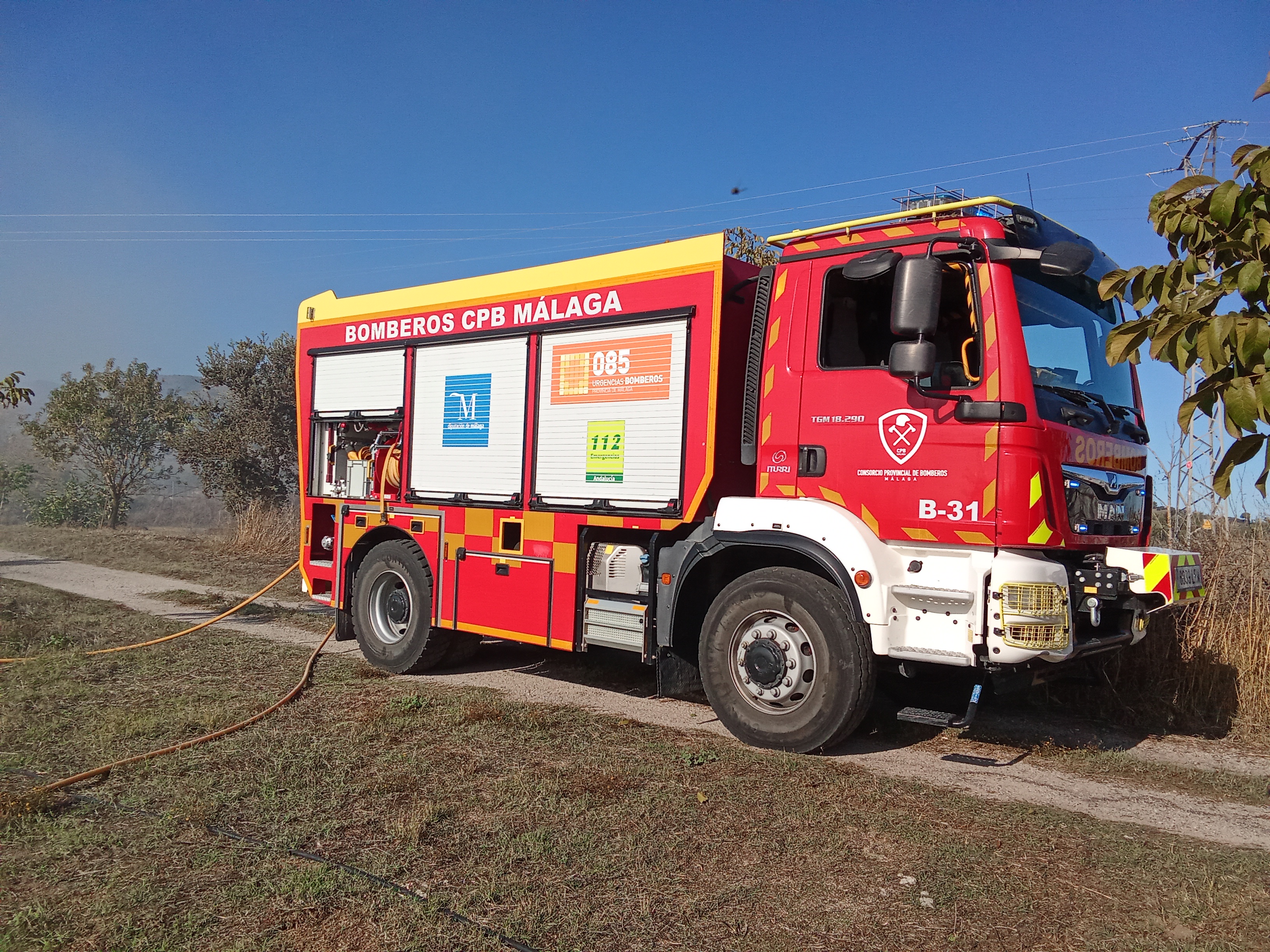  
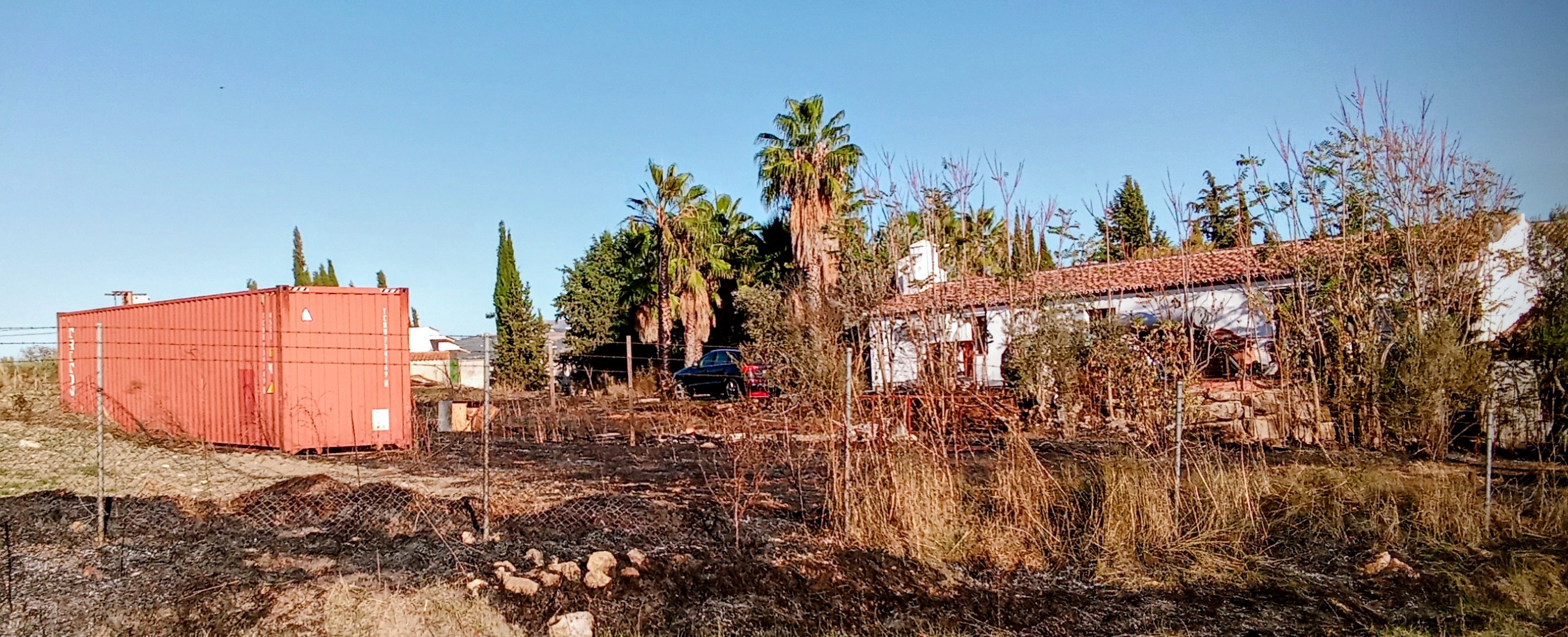 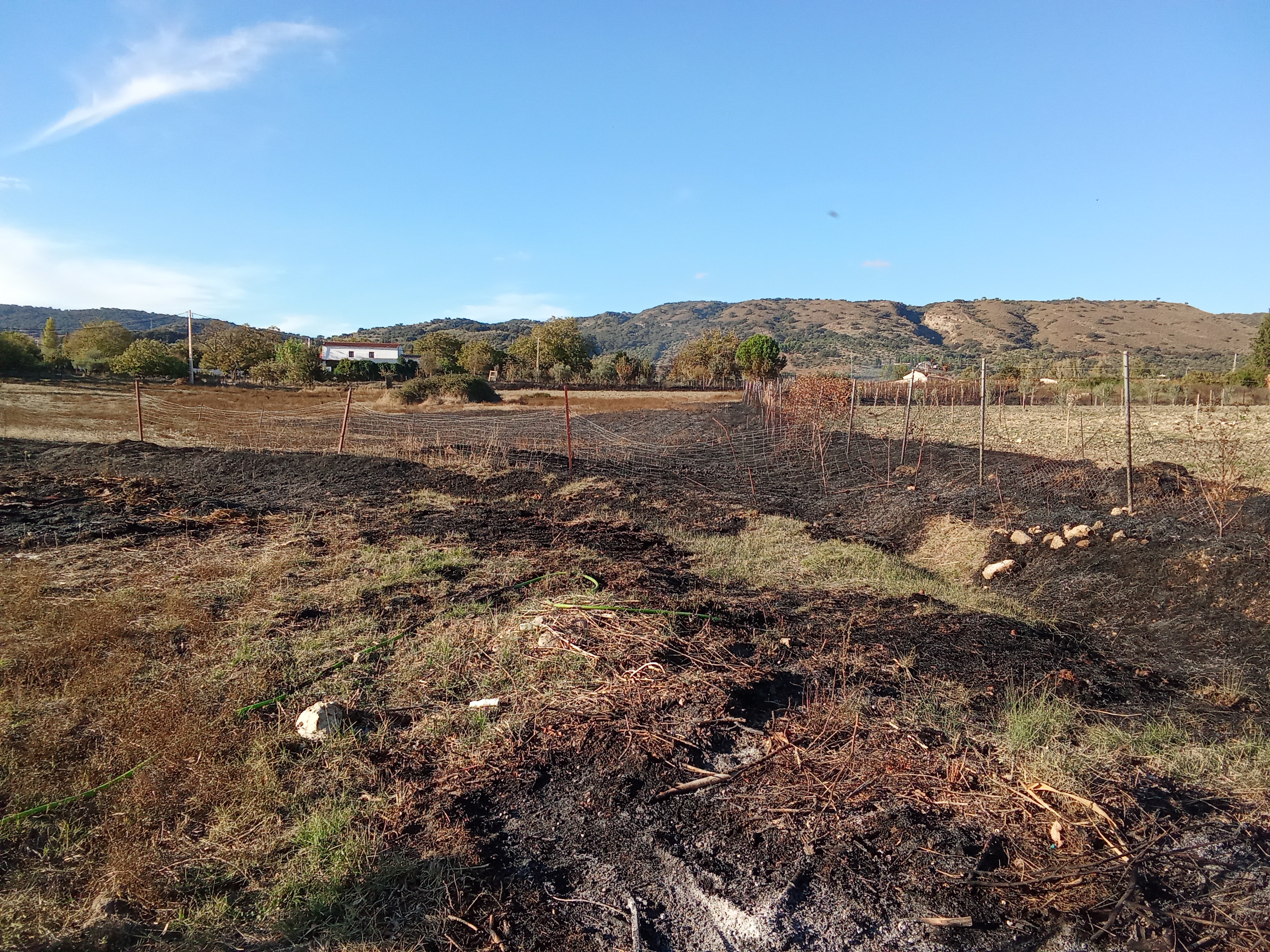
[Above photos by Paul Whitelock]
Dinner time
We had all pre-selected our three courses. I started with gambas (prawns) in filo pastry, followed by filetes de lubina and ending with Apfelstrudel. The wine was included, but I drank very little (too busy talking!).
 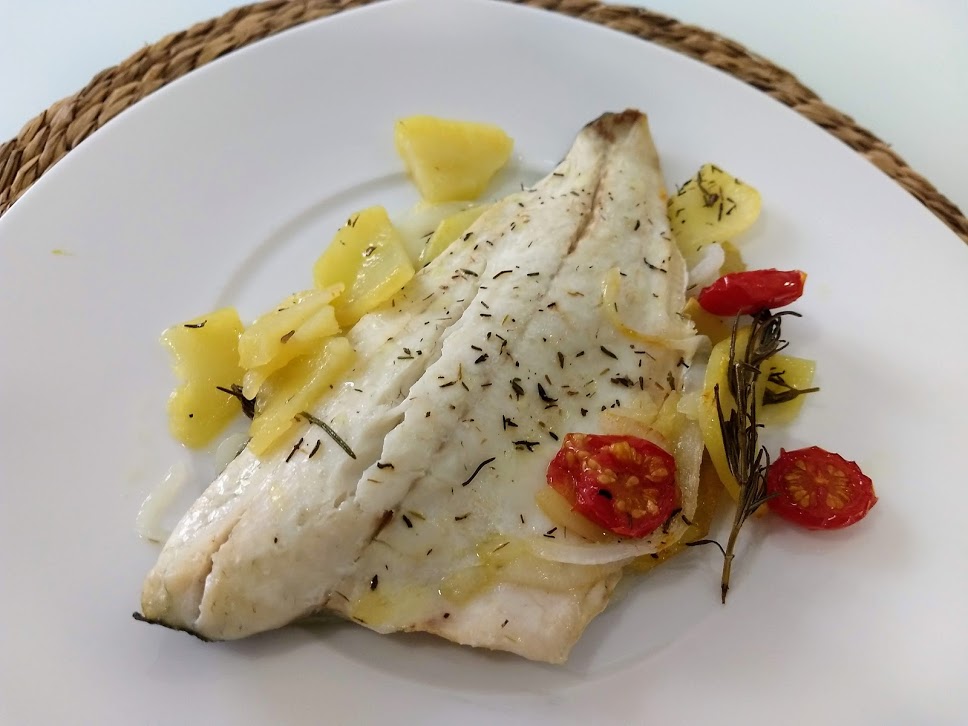 
gambas en filo [eurodrop] filetes de lubina [commememucho] Apfelstrudel [eurodrop]
The 21 members and guests enjoyed the evening: the presentation; the food; and the chit-chat over dinner.
 Sadly, it was all over by 10.00 pm, so we headed off home. Sadly, it was all over by 10.00 pm, so we headed off home.
Or, in my case, to my hotel in Fuengirola, the delightful three-star Hotel Agur, where I had a double room with balcony, private bathroom, TV and free WiFi for a mere 45,54€.
The secure car park cost 15€ for 24 hours.
Hotel Agur [Photo: Trivago]
Footnote:
I try to do these Press nights in as eco-friendly a manner as possible, by taking public transport (bus and train), finding cheap accommodation and walking a lot.
 On this occasion, the bus and train would not have worked to get to Fuengirola. On this occasion, the bus and train would not have worked to get to Fuengirola.
Yet my room was more economical than my last "cheap hotel" in Málaga, and much better, in every respect.
The most costly item that day, relatively speaking, was my nightcap, a half litre of Paulaner Hefeweizen (wheat beer), which cost an eye-watering 6.50€.
My room at the Hotel Agur [Paul Whitelock]
The next morning I opted for the hotel's buffet breakfast at 9.50€. An absolute "snip" for the choice and for the amount I managed to consume! I needed no lunch!
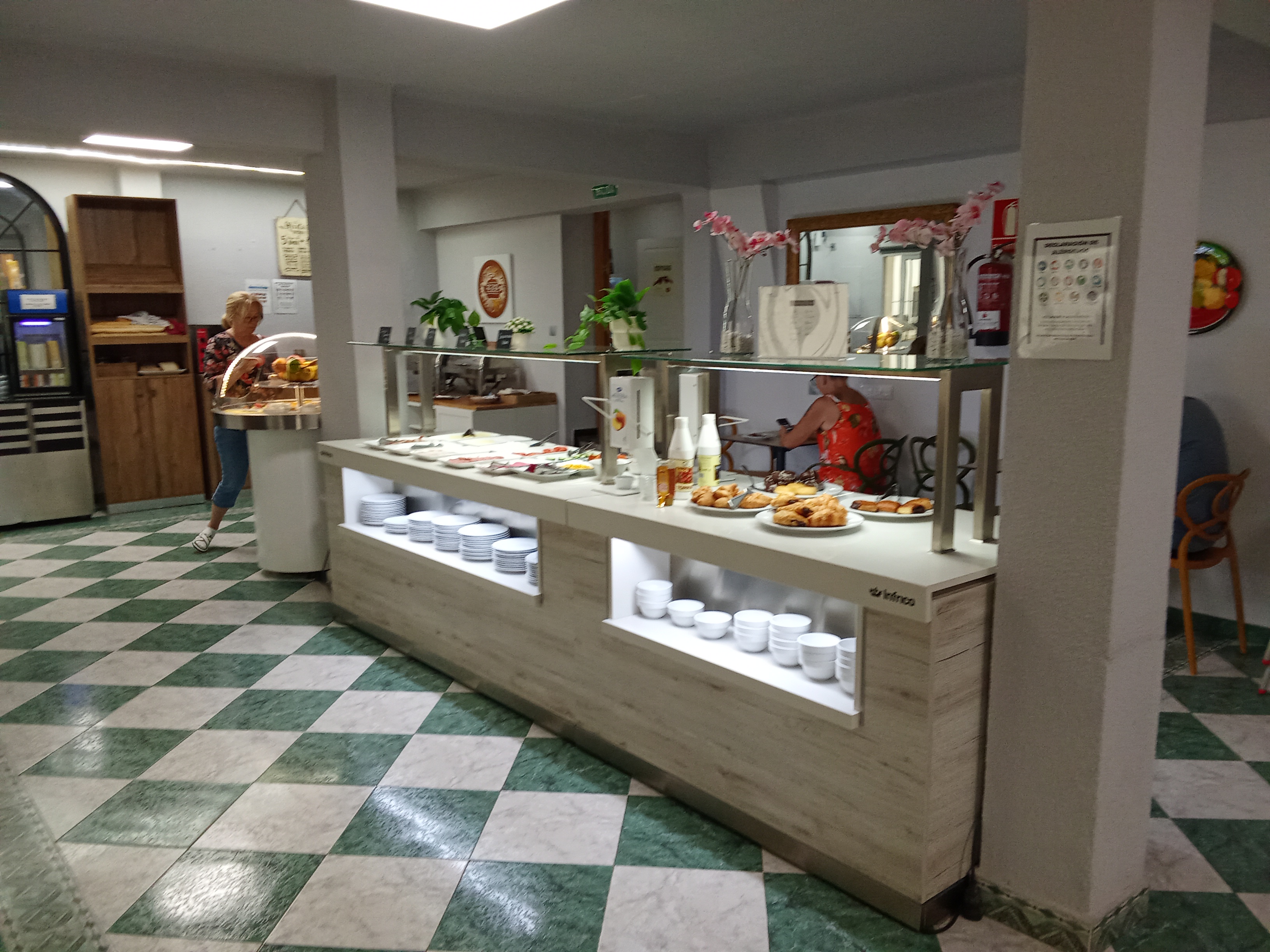
The splendid breakfast buffet at Hotel Agur in Fuengirola
  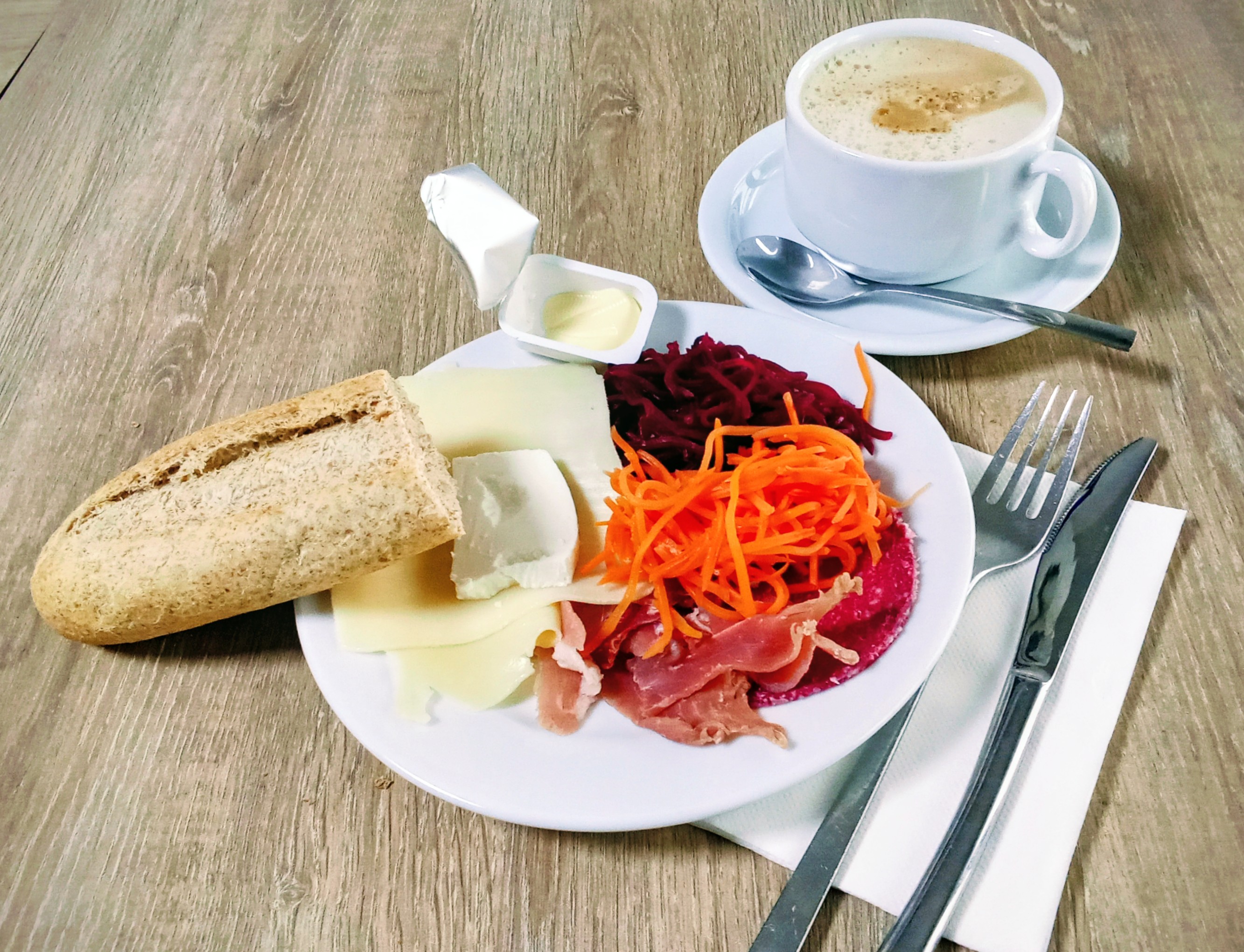 
Fruit and juice to start Bacon, egg and baked beans Cheese, salchichon, shredded veg "pain au chocolat"
[All breakfast photos by Paul Whitelock]
Links:
BREAKING NEWS - DANA – Who or what is it?
Costa del Sol Foreign Journalists Association | Costa Press Club
fernando.comunica@gmail.com
uma.es
www.help-me-ronda.com
www.secretserrania.com
© Pablo de Ronda (Paul Whitelock)
Photos:
commememucho, EL PAIS, eurodrop, Karl Smallman, Paul Whitelock, The Guardian, Trivago
Thanks:
Fernando Fernández Alcaide, Karl Smallman, La Sierra restaurant, Neil Hesketh, Paul Whitelock
Tags:
Andalucia, apagon, ANEPPCE, Cerro de Aguila golf club, Chernobyl, Club de prensa de la Costa del Sol, commememucho, Costa Press Club, crisis management, dana, Digital Volunteers in Emergencies, ébola, EL PAIS, eurodrop, Fernando Fernandez Alcaide, Fuengirola, "Journalists as lifesavers", Karl Smallman, La Sierra restaurant, National Emergency Communication Committee of the National Association of Professional Specialists in Emergencies and Civil Proteccion, Neil Hesketh, Paul Whitelock, The Guardian, train crash in Galicia in 2003, Trivago, Universidad de Malaga, Valencia, VOST
áéíóú
 1
Like
Published at 12:28 PM Comments (0)
1
Like
Published at 12:28 PM Comments (0)
Boycott US Products!
Friday, October 31, 2025
 In protest at the catastrophic and highly damaging "regime" of President Donald J. Trump, the "Orange One", in the United States of America, I, like many others, have decided to boycott products from the USA. In protest at the catastrophic and highly damaging "regime" of President Donald J. Trump, the "Orange One", in the United States of America, I, like many others, have decided to boycott products from the USA.
I also have no wish ever to go there again. They probably wouldn't let me in anyway, after what I've written about the racist, sexist, convicted criminal who is inexplicably in charge of the world's most powerful country.
[Image courtesy of Red Bubble]
My Backstory
I have been to the States once, back in 1998, when my young family and I - wife Jeryl, and children Amy (15) and Tom (12) - spent a month, taking in New Orleans, Los Angeles, Malibu, Stanford University, San Francisco, Yreka, Tacoma and Seattle.
  
New Orleans [expedia.es] San Francisco [Lufthansa] Seattle [Conde Nast Traveler]
We were hosted throughout by family and friends, which meant we had a more meaningful experience - at least, we thought so.
 Yet even back then, nearly three decades ago, there were things I didn't like: the blatant racism against Native Americans (Red Indians), African Americans (blacks) and Mexicans ('Spics); the less obvious negative attitude towards Poles (Polacks), the Irish (Micks or Paddys) and Italians (Eyeties or Dagos); the dreadful food; the ridiculous licensing laws; compulsory tipping and poor quality hotels, infested with cockroaches and rats. Yet even back then, nearly three decades ago, there were things I didn't like: the blatant racism against Native Americans (Red Indians), African Americans (blacks) and Mexicans ('Spics); the less obvious negative attitude towards Poles (Polacks), the Irish (Micks or Paddys) and Italians (Eyeties or Dagos); the dreadful food; the ridiculous licensing laws; compulsory tipping and poor quality hotels, infested with cockroaches and rats.
[Photo: Amnesty International USA]
And it was all very expensive, even back then.
The current state of affairs
 Nowadays, following two disastrous Trump administrations, Joe Biden in between, and before them, Bill Clinton, George W. Bush and Barak Obama, whose legacies are not as good as they might have been, the USA has become a lawless land reminiscent of The Wild West. Nowadays, following two disastrous Trump administrations, Joe Biden in between, and before them, Bill Clinton, George W. Bush and Barak Obama, whose legacies are not as good as they might have been, the USA has become a lawless land reminiscent of The Wild West.
School shootings have increased beyond all proportion and forest fires - mostly arson - have laid waste, land, properties and left many dead.
[Photo courtesy of Rolling Stone]
My Boycott
 So back to the purpose of this article - my boycott of all things American. So back to the purpose of this article - my boycott of all things American.
I no longer buy American clothes, preferring clobber made by slaves in the Far East, rather than American slaves! Asian garments are readily available in Europe at a good price.
[Image: Hula Global]
I do not use American-owned airlines and I have never owned an American car. And, "sure as eggs", I won't be buying a TESLA anytime soon!
American Food
Nothing American gets into my shopping trolley.
 I have stopped buying Heinz Baked Beans, although the ones we get in Europe are produced in Wigan (UK), Paris (France) or La Rioja (Spain). I have stopped buying Heinz Baked Beans, although the ones we get in Europe are produced in Wigan (UK), Paris (France) or La Rioja (Spain).
There are plenty of alternatives whose origins are in France, Ireland, Spain and the UK. And they are invariably cheaper than H J Heinz.
HP Sauce is also owned by Heinz, but it is produced in Italy and Spain. So, that's ok, I think.
[Amazon]
Beer and Wine
US beer is virtually undrinkable, so I never buy Budweiser nor Coors. is virtually undrinkable, so I never buy Budweiser nor Coors.
Budvar, from the Czech Republic, is a different matter. It's a fine beer.
Beers on sale in the USA [PUNCH]
 American wines, eg from California, are delicious, but there are wines available elsewhere which are just as good. American wines, eg from California, are delicious, but there are wines available elsewhere which are just as good.
I'm talking about Austria, France, Germany, Italy, Luxembourg and Spain, as well as countries like Croatia, Greece, Hungary and Turkey.
Wine from Alsace, France [Grape Escapes]
A Confession
 I recently switched my internet provider to a company called Starlink and signed up for a one-year deal. I recently switched my internet provider to a company called Starlink and signed up for a one-year deal.
I subsequently learned that Starlink is owned by the ghastly Elon Musk, he of TESLA fame!
However, Musk is South African, isn't he? So, that's OK, or, is it ..... ?
Elon Musk's infamous Nazi salute [Photo: The Guardian]
Links:
© Pablo de Ronda (Paul Whitelock)
Images:
Amazon, Amnesty International USA, Conde Nast Traveler, El periodico, expedia.es, Grape Escapes, Hula Global, Lufthansa, PUNCH, Rolling Stone, The Guardian, Wikipedia
Thanks:
Google Images, Wikipedia, www.help-me-ronda.com
Tags:
Alsace, Amazon, American car, Amnesty International USA, baked beans, Conde Nast Traveler, Elon Musk, El Periodico, expedia.es, Grape Escapes, Heinz, Hula Global, Los Angeles, Lufthansa, Malibu, New Orleans, Pablo de Ronda, Paul Whitelock, PUNCH, Rolling Stone, San Francisco, Seattle, Stanford University, Starlink, Tacoma, The Guardian, Trump, Wikipedia, Yreka
 0
Like
Published at 4:21 PM Comments (0)
0
Like
Published at 4:21 PM Comments (0)
What a surprise!
Thursday, October 16, 2025
 When Charlie Mullins became a regular columnist for The Olive Press newspaper, I thought: When Charlie Mullins became a regular columnist for The Olive Press newspaper, I thought:
"Omigod! Jon Clarke (editor of said free paper published in Southern Spain) has hired a 'Leapy Lee', the racist, sexist, failed pop-star pr**k who writes for the EuroWeekly News (another free paper here on the coast)".
Charlie Mullins, OBE [Photo: Elite Business Magazine]
The story
Mullins' debut column didn't augur well for the future, I have to say.
However, since then this self-made millionaire who has decided to make his home in Estepona, Spain, has grown on me.
His recent column (Vol. 19, Issue 478) tackles the issue of immigration.
"You don't have to scroll far these days to find someone sounding off about immigration - whether it's in the UK or right here in Spain."
Writing about the many "Brits" who have made Spain their home, he opines that the "Spanish people have been incredibly welcoming" towards him.
[Photo: Issuu]
He contends that this is because he has always shown respect for their country, their way of life, and their culture.
He writes: "This isn't about Spain v. the UK, or locals v. expats. It's about decent people who make an effort, versus those who turn up with a sense of entitlement and no interest in fitting in".
As he writes, they are loud, brash, no manners, no clue. I agree.
A typical 'guiri' [Photo: Facebook]
Mullins claims he has never pretended to be Spanish. He lives in Spain, and is a "guest", which brings responsibilities. I agree absolutely. We will always be "guests".
 He refers to the British "expat" lady who left the UK because there were "too many foreigners", and moved to live in Spain. He refers to the British "expat" lady who left the UK because there were "too many foreigners", and moved to live in Spain.
She is now exactly that, a foreigner. In Spain. She has made no attempt to integrate.
"Guiris" [Daily Express]
Mullins is quite accepting of her - I am most definitely not! She is a hypocrite big-style!
In conclusion, Mullins writes: "This isn't about being anti-immigrant, it's about being anti-ignorant".
You have "hit the nail on the head", my friend.
Well done!
And well done to The Olive Press for hiring an excellent columnist, Charlie Mullins, OBE!
© Pablo de Ronda (Paul Whitelock)
Pictures:
Daily Express, Elite Business Magazine, Facebook, Issuu
Thanks:
Paul Whitelock, The Olive Press, Wikipedia
Tags:
Charlie Mullins, Daily Express, Elite Business Magazine, Estepona, EuroWeekly News, Facebook, guiri, Issuu, Jon Clarke, Leapy Lee, Pablo de Ronda, Paul Whitelock, The Olive Press, Wikipedia, www.help-me-ronda.com
 0
Like
Published at 9:50 PM Comments (0)
0
Like
Published at 9:50 PM Comments (0)
History of the Press in Malaga
Friday, October 3, 2025
 This latest meeting of the Costa Press Club (Club de Prensa de la Costa del Sol) was a real treat. Laura López of the University of Malaga’s Faculty of Communication Sciences led us on a walking tour of important sites and landmarks which tell the history of journalism in the city. This latest meeting of the Costa Press Club (Club de Prensa de la Costa del Sol) was a real treat. Laura López of the University of Malaga’s Faculty of Communication Sciences led us on a walking tour of important sites and landmarks which tell the history of journalism in the city.
[Photo: Neil Hesketh]
 Laura lectures on the topic to undergraduate students and always includes this tour as part of the course. Laura lectures on the topic to undergraduate students and always includes this tour as part of the course.
On Tuesday of this week, she gave us journalists, media people and communicators the very same tour.
[Photo: Neil Hesketh]
Ruta por la Malaga periodistica (siglo XIX-XX)
 There were nine "stops" on our tour, which covered the History of the Press in Malaga in the 19th and 20th centuries. There were nine "stops" on our tour, which covered the History of the Press in Malaga in the 19th and 20th centuries.
Highlights included the workplace of Antonio Cánovas del Castillo, who began as a journalist before becoming Spain’s prime minister .....
..... and the archive of Narciso Díaz de Escovar, chronicler of Malaga’s bourgeois era.
[Photo: Paul Whitelock]
 CPC members and their guests also heard stories of political conspiracies, murders, and the Civil War divisions between republicans and monarchists, which had tragic consequences for journalists. CPC members and their guests also heard stories of political conspiracies, murders, and the Civil War divisions between republicans and monarchists, which had tragic consequences for journalists.
Laura emphasised two themes:
Malaga’s overlooked status as a pioneering press hub, rivalling Madrid and Barcelona;
and the relatively recent professionalisation of journalism, once dominated by lawyers, politicians, and writers.
The tour concluded with a reference to the Asociación de la Prensa de Málaga, Spain’s first press association, currently celebrating its 120th anniversary.
[Photo: Daryl Finch]
Time for Dinner!
Tour over, we were hungry and thirsty. We went for dinner to the delightful Restaurante El Gallo Ronco, where we enjoyed a selection of delicious tapas and raciones and chatted about the tour ..... and other things too!
 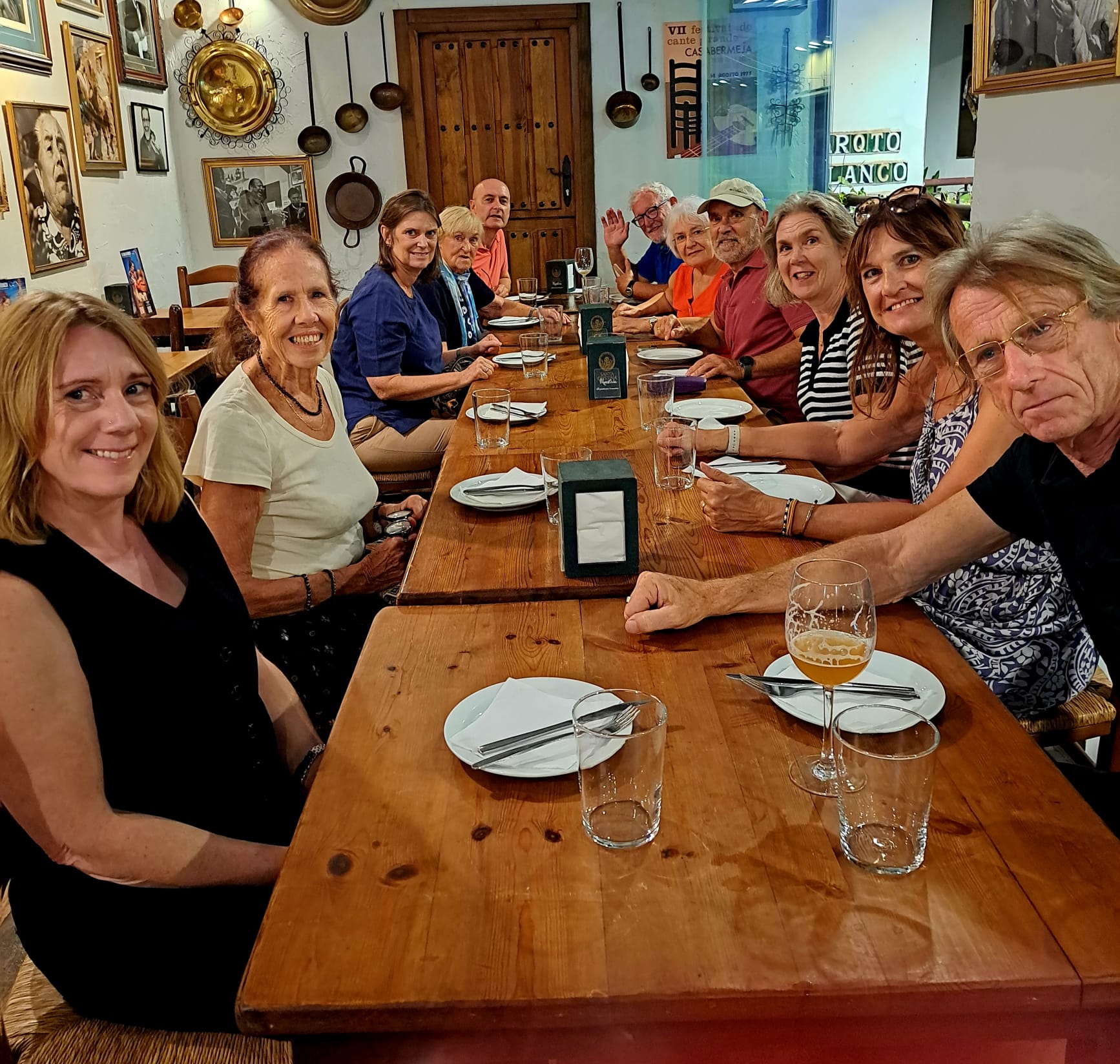
[Photo: Paul Whitelock] [Photo: Joanna Styles]
I met a couple of people I didn't know, including Neil's 92-year-old mum in Malaga on a visit from Liverpool, and Jose Maria, aka "Mister Joanna Styles".
A memorable evening!
All I had to do now was find my hotel ..... which proved to be easier said than done!
But that's a story for another day .....
© Pablo de Ronda
Photos:
Daryl Finch, Joanna Styles, Neil Hesketh, Paul Whitelock
Acknowledgements:
Costa Press Club, El Gallo Ronco, Joanna Styles, Laura López, Liz Parry, Neil Hesketh
Tags:
Antonio Cánovas del Castillo, Asociación de la Prensa de Málaga, Barcelona, Club de Prensa de la Costa del Sol, Costa Press Club, Daryl Finch, El Gallo Ronco, History of the Press in Málaga, Joanna Styles, Laura López, Liz Parry, Madrid, Narciso Díaz de Escovar, Neil Hesketh, Pablo de Ronda, Paul Whitelock, Ruta por la Malaga periodistica, University of Malaga
 0
Like
Published at 7:09 PM Comments (0)
0
Like
Published at 7:09 PM Comments (0)
"The White Pearl"
Saturday, September 27, 2025
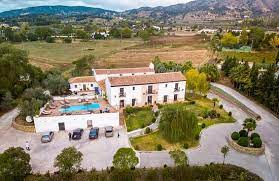 Sounds like a pirate ship, doesn't it? I'll come back to that later. Sounds like a pirate ship, doesn't it? I'll come back to that later.
"La Perla Blanca" is a small boutique hotel in Fuente de la Higuera, Ronda. It backs onto my garden, so we're neighbours.
Aerial view of La Perla Blanca[Trip Advisor]
It's a charming place, well, was - I've heard it's gone downhill lately, but we'll come back to that too.
"La Perla Blanca" 2011
When we moved to our new "home" in February 2011, we got to know the incumbent "landlords". The hotel is leased from the owner, allegedly the richest man in Ronda.
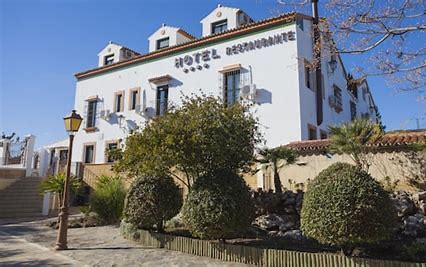 The landlords back then were a German couple and we got quite friendly with them. Then, all of a sudden they were gone! The landlords back then were a German couple and we got quite friendly with them. Then, all of a sudden they were gone!
The next incumbents were Dutch. We knew them too. They took over the Hotel Don Benito as well, but they didn't make a success of either and did a "runner" leaving a trail of debt!
A couple from South Africa had a go, but they didn't last long either!
Hotel Don Benito, now Hotel Ronda Valley [Central de Reservas]
"La Perla Blanca" 2015
Next came S, a Yorkshireman, and his wife. They came from the Caribbean where they had been working on yachts as crew.
They split up within a short time, but S stayed. He put his heart and soul into "La Perla Blanca", renovated the rooms, changed the public areas and worked hard on the extensive grounds.
After a while he took up with a Scottish Widow (No, not the insurance company!), who had been living in the area for years. We all knew her. She moved in and took charge of the cleaning, changeovers, etc.
Then, all of a sudden, S gave up the lease and moved in with this lady (she has asked to remain anonymous). He started work as a peon - a builder's labourer - and proved to be very good at it. He worked for me and regularly for K, an English builder friend of us all.
Next, the couple went back to the UK, to Huddersfield, S's home town. I don't know the details, but I understand that he stayed there and she came back to Andalucía.
"La Perla Blanca" - the pirate era
 The "pirate" was J, Scottish-born, but from Leeds. His gorgeous much younger wife, also J, also came from Leeds. They had had two children together, who shall remain nameless. They all came out and took over the hotel. The "pirate" was J, Scottish-born, but from Leeds. His gorgeous much younger wife, also J, also came from Leeds. They had had two children together, who shall remain nameless. They all came out and took over the hotel.
I helped them get their kids in school in Ronda, and enrolled the parents on a language course. J never attended.
At the beginning of their tenure they did good things and the hotel was often full. We became friends, as well as neighbours.
J was very generous, and often bought our drinks. He even loaned me his Land Rover to go to the coast to pick up some furniture I'd bought down there.
Next I bought his VW Transporter from him, which he later incinerated in a drunken rage. It was a write-off!
"J" [Courtesy of Freepik]
The police know it was him, and so do several neighbours, but they refused to help the police investigators. Great neighbours, eh?
J eventually did a prolonged "midnight flit" and went back to the UK leaving a trail of debts behind him. Astonishingly, Spain and the UK do not have an extradition treaty, so he's got away with it!
Last I heard he and J have divorced and, according to HIS OWN POSTS ON FACEBOOK, he spends a lot of time in the Philippines in the company of teenage prostitutes.
What was the attraction, we all wonder? J was short, fat, ugly, bald and operated "under the radar".
Either he's "good in the sack" or these women are attracted by his money.
Disclaimer: Having taken legal advice I have been assured that I am entitled to name J because, as far as the police in Ronda are concerned, he is guilty of arson. It is therefore legitimate to "name and shame" him. However, I shall not do so. J is regrettably "out of reach" because of the lack of an extradition treaty between Spain and the UK.
[The names of everybody mentioned in this article have been anonymised, in accordance with current journalistic practice.]
"La Perla Blanca" - post-thug
T, from South Africa, took over the lease and, once settled, brought his wife and children over. I met T a few times, but he preferred to keep himself to himself. I only met his wife and oldest daughter once.
Then, they too suddenly went ..... to be replaced by .....
E, a Dutchman with an estate agency on the Costa del Sol. I never met E, but met his lovely Colombian wife.
Then, they too disappeared .....
They have been replaced by a Moroccan couple, who I've not clapped eyes on yet. Rumour has it that they've let "The White Pearl" go. That would be a great shame.
Should I go round and introduce myself?
(Answers on a postcard to .....)
© Pablo de Ronda
Pictures:
Central de Reservas, Freepik, Trip Advisor,
Links:
LA PERLA BLANCA - RONDA - Official Site. Book Direct and breakfast is FREE
Importing a UK vehicle to Spain and re-registering it onto Spanish number plates
Tags:
Caribbean, Central de Reservas, Freepik, Huddersfield, La Perla Blanca, Hotel Ronda Valley, Land Rover, Leeds, Pablo de Ronda, Paul Whitelock, Philippines, Ronda, South Africa, teenage prostitute, Trip Advisor, VW Transporter
 0
Like
Published at 5:18 PM Comments (2)
0
Like
Published at 5:18 PM Comments (2)
Nicknames
Sunday, September 21, 2025
In Andalucia every man has a nickname - "un apodo". The women don't. Whether men have "apodos" in other parts of Spain I am not sure.
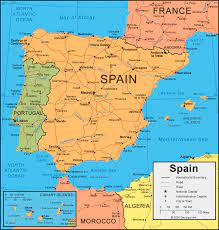
I've travelled the length and breadth of the country for more than fifty years and have lived for periods in Barcelona (Catalonia); El Prat de Llobregat (Barcelona); Extremadura; Frigiliana (Málaga); Jaca (Aragon); Madrid; Olot (Girona); Oviedo (Asturias); and San Sebastián (Guipuzkoa). I've never noticed the widespread use of nicknames in those areas.
[Anon.]
Some of us "guiris" have "coined" nicknames too, but for things, rather than people.
"Apodos"
"Apodos" have proved a challenge for me, and doubtless for other foreigners of a certain age, in that as we become ever more forgetful, to have to learn "two names" for every male is really difficult!
Who are Caniche, Chico, El Gitano, Jesulin de Ubrique, La Raspa, and Pingu?
Antonio, Alonso, Diego, Álvaro, Javi and - por Dios, I've forgotten Pingu's real name! (Just kidding - he's called Cristobal!)
Nicknames
 Monty Jack, Ben and Joan and Big Ron are recognisable as Montejaque, Benaoján and Ronda (the first two courtesy of Bill La Peche, an Englishman who lived round these parts. Bill sadly died some 14 years ago, but his widow Jill still delights in using these witty alternative names. Monty Jack, Ben and Joan and Big Ron are recognisable as Montejaque, Benaoján and Ronda (the first two courtesy of Bill La Peche, an Englishman who lived round these parts. Bill sadly died some 14 years ago, but his widow Jill still delights in using these witty alternative names.
Bill La Peche superimposed on a photo of Montejaque [Karl Smallman]
Mercadonuts and The Chocolate Moose are two more of Bill's, the latter referring to a chocolate coloured statue of a stag located to the north-west of Ronda.
"Noms de plumes"
Many writers over the centuries used "noms de plume" to hide their true identity, mainly female authors who used men's names because of the male-dominated literary world, eg George Eliot (Mary Anne Evans) and George Sand (Amantine Lucile Aurore Dupin de Francueil).
 
Photos of George Eliot and George Sand [both courtesy of Wikipedia]
But who were Currer, Ellis and Acton Bell? (Answer below).
Anonymous bloggers
Nowadays many bloggers use a nickname in an attempt to hide behind a cloak of anonymity as they peddle their extreme views, their bullying and their "hate speech".
Here are some I come across regularly: BrainwashReigns, El Bombero and lesleyfb. Despite challenging these people to come clean, they refuse.
 I use "pen names" too, but it's easy to know who I really am. I use "pen names" too, but it's easy to know who I really am.
I am not ashamed of what I write and post.
I am currently Der Auslands-Korrespondent, Diary of a Nobody, Don Pablo, Only Joe King, Pablo de Ronda, Serrania Kitchen, Sporty Sam, The Crazy Guy, The Culture Vulture, The Curmudgeon, The DIY Guy, The "Guiri" Gourmet, The History Man, The Merry Tippler, The "Namer and Shamer", The Spanish Fly.
Each of these "threads" deals with a different topic, as the nickname in each case implies.
But they are all me - Paul Whitelock.
Paul Whitelock aged 21 [Photo: Dave Holt]
Answer to quiz question:
Currer, Ellis and Acton Bell were the Brontë sisters, Charlotte, Emily, and Anne.
Links of interest:
Ben and Joan, Monty Jack and Big Ron - Eye on Spain (2021)
Ben and Joan, Monty Jack and Big Ron - Help me, Ronda (revised version 2024)
Ben and Joan, Monty Jack and Big Ron - Olive Press News Spain (original version 2010)
My Special Places in Spain - Eye on Spain
Remembering Bill - Secret Serrania de Ronda
What is a guiri? It's what the Spanish call us foreigners - but is it good or bad? - Secret Serrania
© Pablo de Ronda
Photos:
Ayuntamiento de Montejaque, Dave Holt, Jill La Peche, Karl Smallman, Paul Whitelock, Wikipedia
With thanks to:
Ayuntamiento de Montejaque, Diego Sanchez Sanchez, Jill La Peche
Tags:
Acton Bell, apodo, Asturias, Ayuntamiento de Montejaque, Barcelona, Ben & Joan, Big Ron, Bill La Peche, BrainwashReigns, Brontë, Catalonia, Chocolate Moose, Currer Bell, Dave Holt, Der Auslands-Korrespondent, Diary of a Nobody, Diego Sanchez Sanchez, Don Pablo, El Bombero, Ellis Bell, George Eliot, George Sand, Guipuzkoa, guiri, Jill La Peche, Jon Clarke, Karl Smallman, lenox, lesleyfb, Madrid, Mercadonuts, Monty Jack, nickname, Only Joe King, Oviedo, Pablo de Ronda, Paul Whitelock, San Sebastian, Serrania Kitchen, Sporty Sam, The Crazy Guy, The Culture Vulture, The Curmudgeon, The DIY Guy, The "Guiri" Gourmet, The History Man, The Merry Tippler, The "Namer and Shamer", The Spanish Fly, Wikipedia, www.help-me-ronda.com, www.secretserrania.com, www.thecollector.com, www.theolivepress.es
 0
Like
Published at 11:47 PM Comments (1)
0
Like
Published at 11:47 PM Comments (1)
Spam post or Abuse? Please let us know
|
|